
In February the World Defense Show (WDS) was held at Riyadh, Saudi Arabia. In 2022 a purpose built event location of some 800.000 m2 was North of Riyadh especially for the first edition of the WDS, a trade show that is not only aiming to be the largest in the region but also one of the largest worldwide.
It is organised by the Saudi General Authority for Military Industries (GAMI) under the patronage of King Salman bin Abdulaziz Al Saud. The second edition, held from 4-8 February, was very successful, with EUR 6,3 billion worth of orders. Some 106.000 visitors could see 773 exhibitors from 76 countries, ranging from small local companies to international heavyweights like British Aerospace and Boeing. The items on show ranged from aircraft and vehicles to guns and ammunition, from inflatable decoys to control room furniture and from boots and uniforms to submarines. Andrew Pearcey, Chief Executive Officer of the WDS, commented: “The 2024 edition of the World Defense Show has provided international exhibitors with access to Saudi Arabia’s ever-growing defence and security market. I look forward to welcoming the global defence community back to Riyadh in 2026.”
We present an extensive overview of the show, based on photographs.
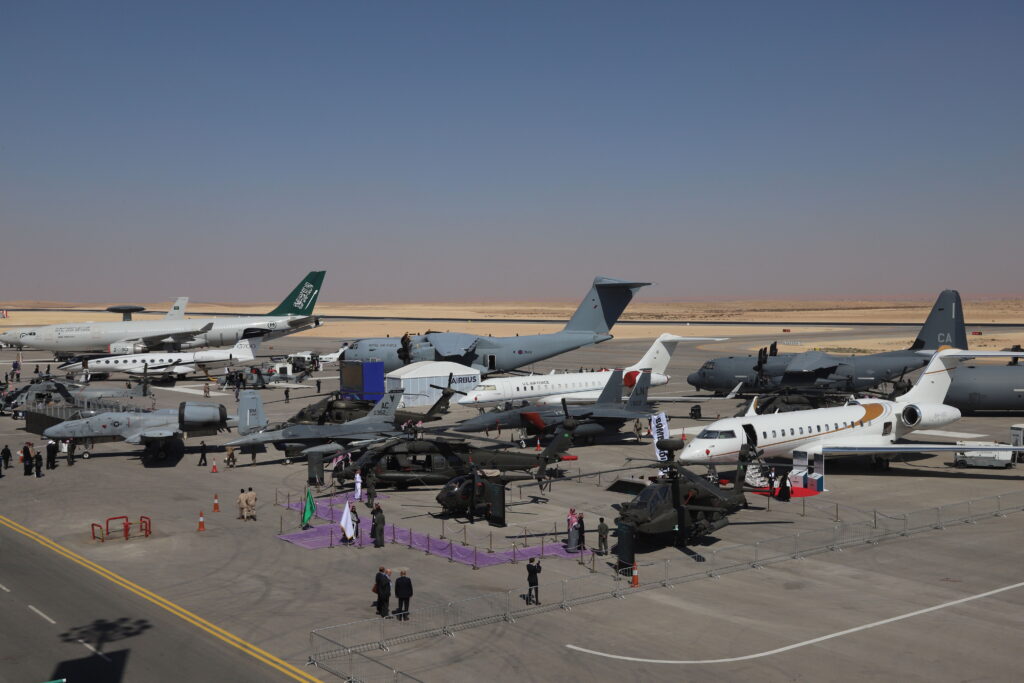
During the five show days multiple live air and ground displays were held. Next to that there was a large static display of aircraft and vehicles, a part of which is seen here. It is dominated by the Airbus A.330 tanker and transport aircraft and A.400 Grizzly.
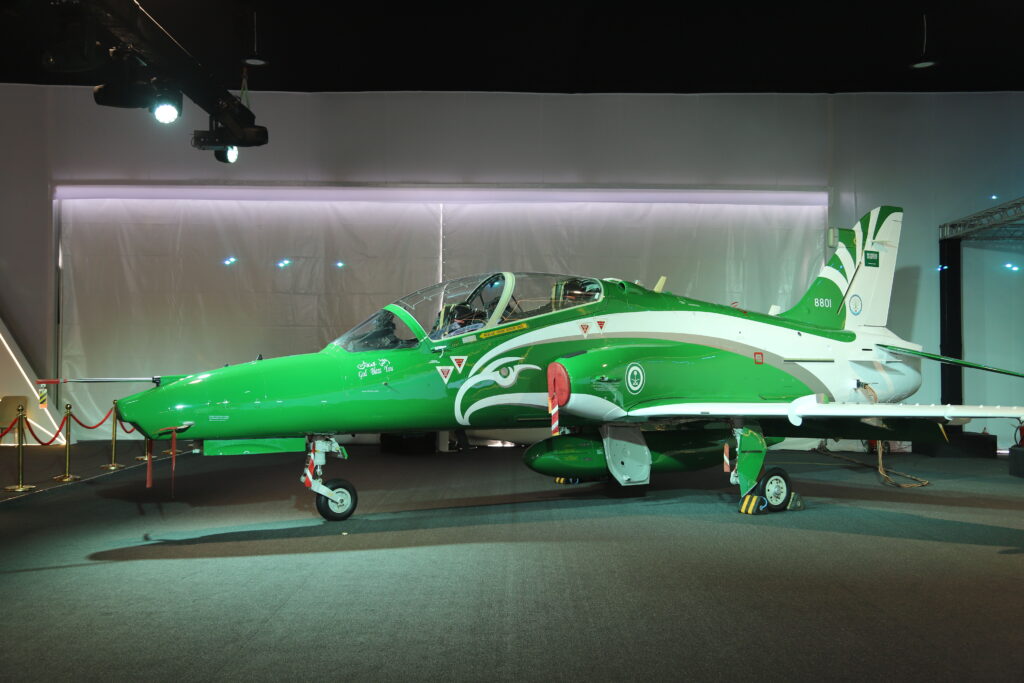
Unveiled on the second day of the show was this British Aerospace Hawk mk.165 in the new Saudi Hawks colour scheme. This demonstration team is currently flying its last season with the Hawk mk.65A, after the summer the type will be phased out and be replaced by the mk.165. It is expected the team needs a year to do the conversion to the mk.165, and will do their first display again in 2026. The new look is still very recognisable, in the green and white colours of the Saudi flag, but has some nice changes including the large Hawk silhouette on the side underneath the cockpit. Plan is to repaint 10 Hawks in total.
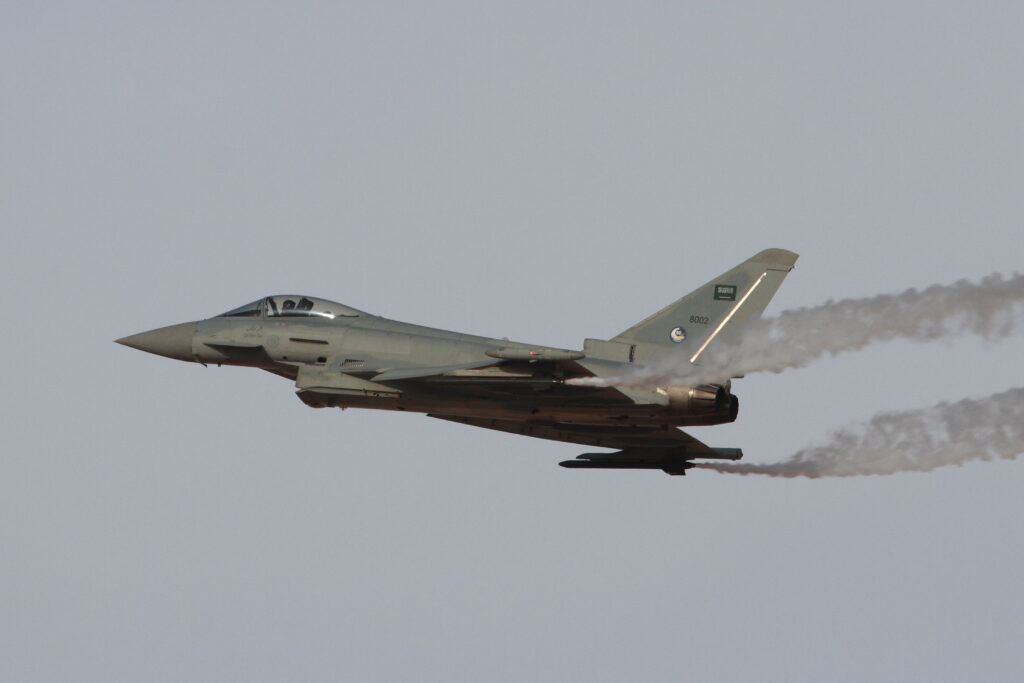
Flying a very impressive display almost daily was the Eurofighter Typhoon of the Royal Saudi Air Force (RSAF). This example is operated by 80 squadron, based at Taif/King Fahd Air Base.
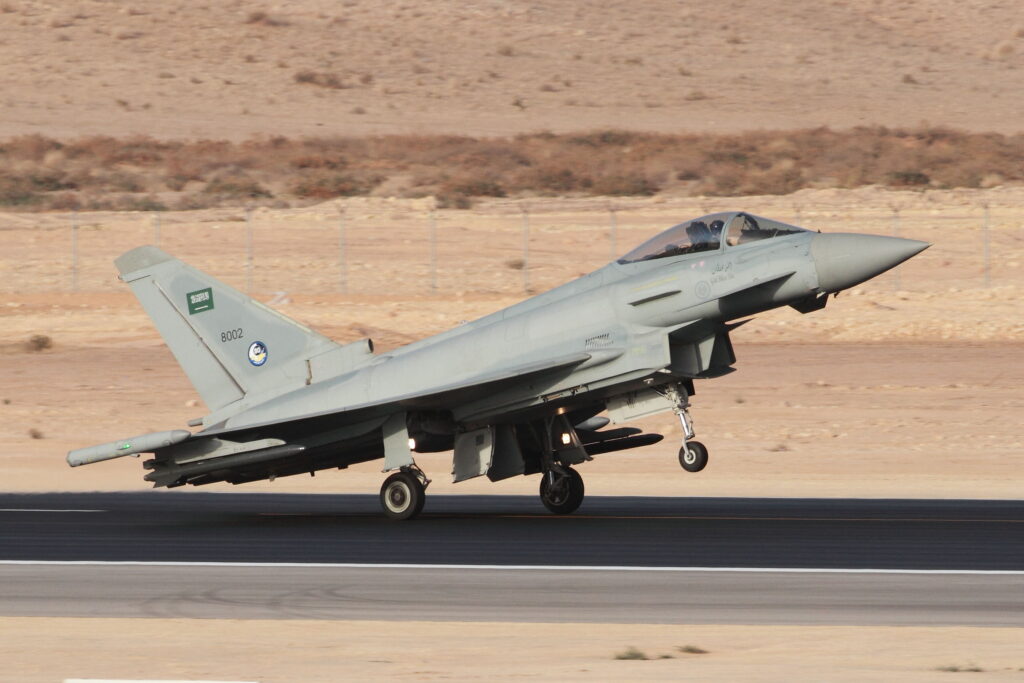
Saudi Arabia ordered 72 Typhoons that were delivered between 2009 and 2017. A follow up order of up to 96 aircraft however never materialised because of an arms embargo imposed in 2018 by the German government, one of four countries that form the Eurofighter consortium (together with the UK, Italy and Spain). According to well-informed British sources there was another factor that halted the follow on order, being the wish of the RSAF to wait for a Typhoon with the cutting edge ECRS mk.2 Active Electronically Scanned Array (AESA) radar. After some delays this new radar was finally implemented in a trials aircraft by BAe at Warton, UK last November, giving the aircraft more or less a 5th generation sensor. Together with the lifting of the arms embargo in January this could well open up the road for that long awaited follow up order.
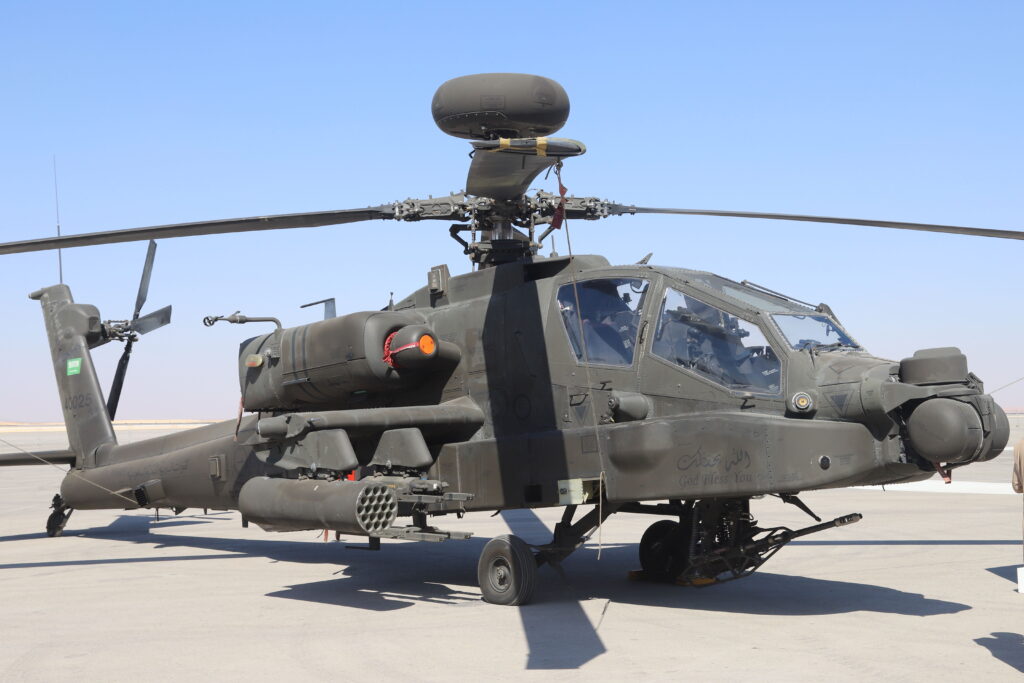
The Royal Saudi Land Forces (RSLF) showed three of their helicopter types at the WDS, including this AH-64E Apache Guardian. This example is one of the first batch of the newly built Echo versions of which the Saudi Land Forces have ordered 34, and that are operated next to some dozen former AH-64As that have been upgraded to the AH-64D Longbow version. The other RSLF helicopters on show were a UH-60M Black Hawk and a brand new CH-47F Chinook. Of that last type 36 have been ordered, so far the first 6 have been delivered to the 3rd Aviation Group based at Tabuk. Also operated by the RSLF, but not present at the show, are the Schweizer 333 training helicopter and the Bell 406 Combat Scout, although unconfirmed reports say this last one has been retired after the delivery of the AH-64Es.
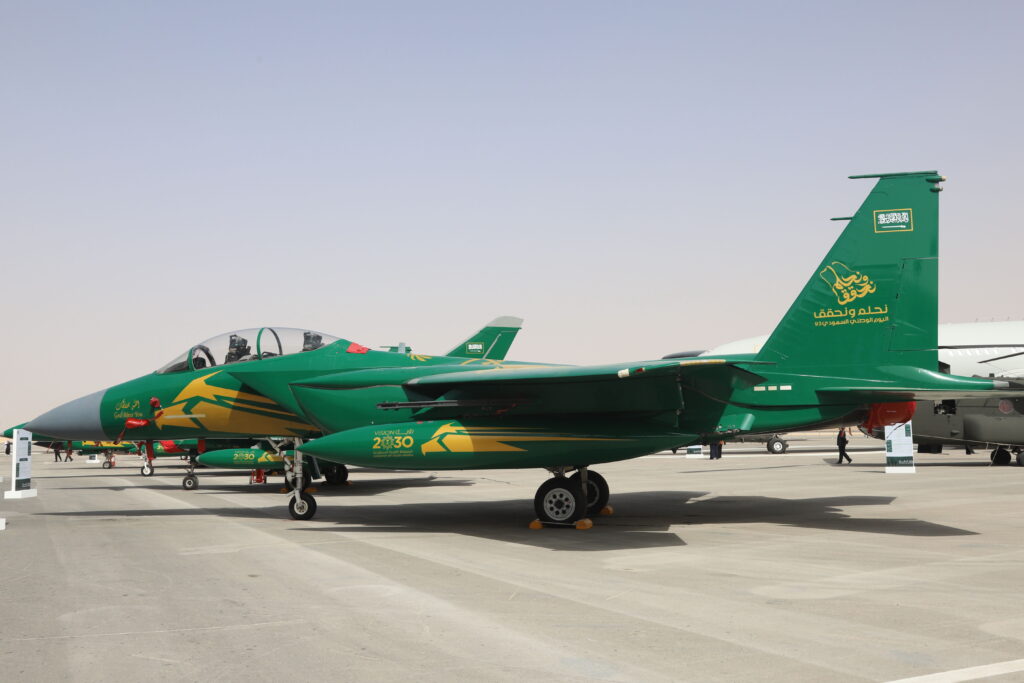
The Saudi national day is celebrated on 23 September, and since five years the RSAF contributes to the festivities with flypasts over the main cities. For this every year some fighter aircraft are painted in a special livery. Four of the ones that did the flypasts a few months back were present in the static display, showing a beautiful all over green colour scheme with golden eagles on the nose, wings and fuel tanks. They were a Eurofighter Typhoon, a Panavia Tornado IDS, a Boeing F-15C Eagle and this F-15S Strike Eagle leading the line-up.
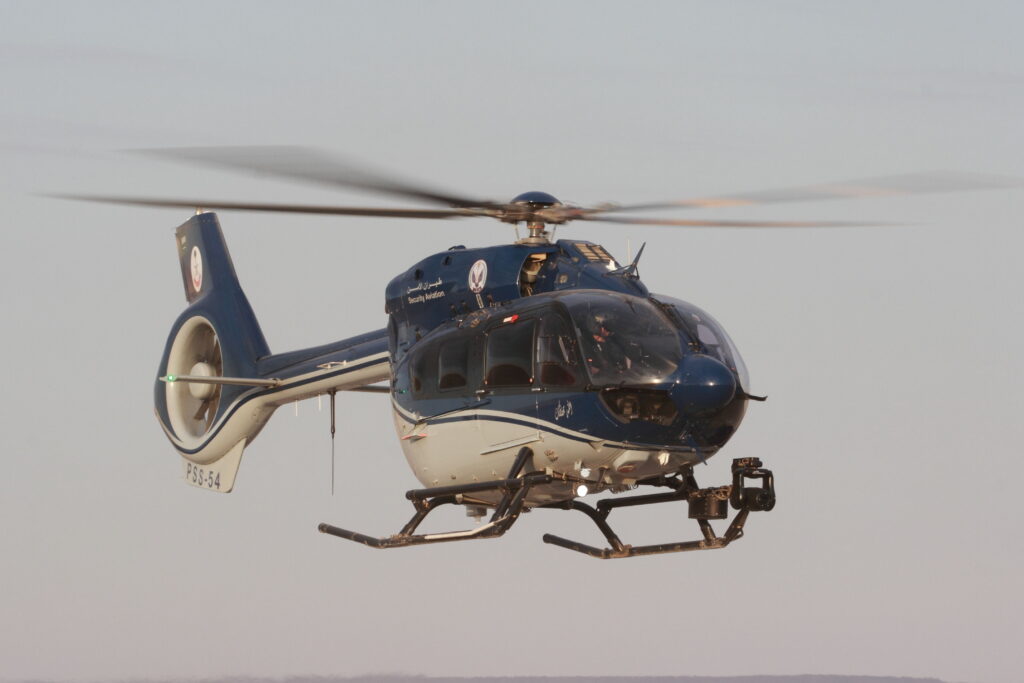
In 2017 multiple Saudi security agencies that operated helicopters were integrated into the Presidency of State Security (PSS). They received a fleet of new helicopters, consisting of the Sikorsky S-92 and S-70i Black Hawk and Airbus H.145, plus the Casa C.295M transport aircraft. One of the H.145T2s was on display inside one of the many halls, while this one was on standby during the show in case of emergency. The PSS focusses on internal security, including counterterrorism, anti-piracy and intelligence gathering, but also humanitarian relief missions in case of natural disasters.
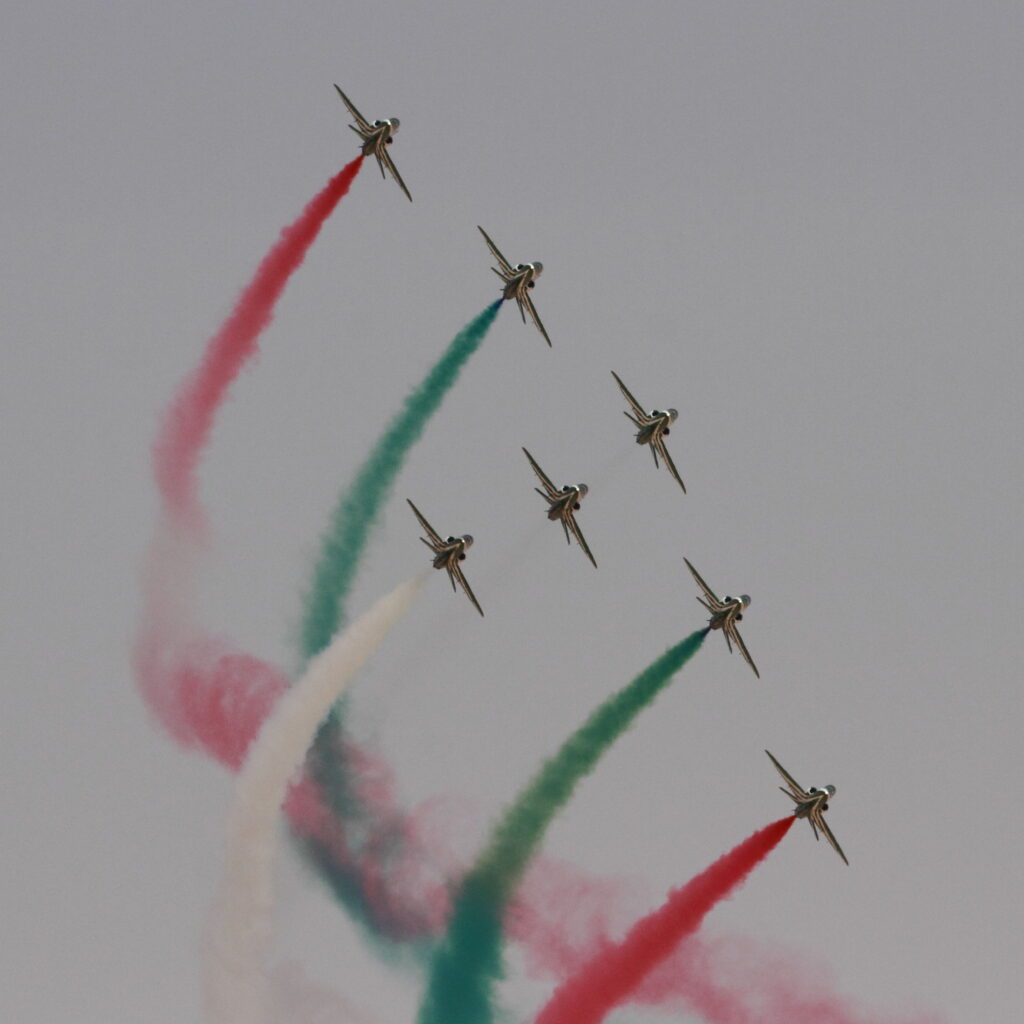
Although officially called Al Suqoor, or Falcons, the Royal Saudi Air Force national display team is better known as the Saudi Hawks. The team flies, not surprisingly, the British Aerospace Hawk mk.65A. Being based at Tabuk/King Faisal Air Base, they are part of 88 squadron. The team was founded in 1998 especially for the upcoming celebrations of Saudi Arabia’s 100th anniversary in January 1999, during which their first display was given over the nation’s capital Riyadh.
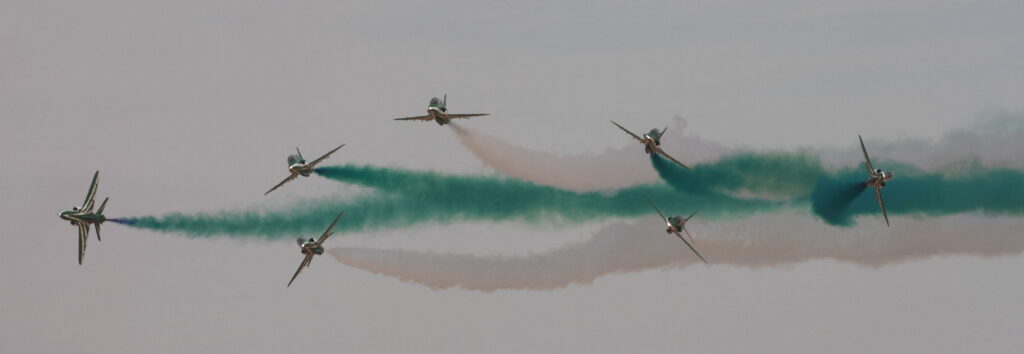
The display typically involves 6 Hawks, painted in the green and white colours of the Saudi flag. Smoke generators are used during the display, with multiple different colours. The display is a mixture of graceful formation aerobatics, breathtaking cross overs and some solo and synchro pair manoeuvres. Although they are not seen abroad too often, over the years the team has displayed in amongst others Bahrain (first display outside Saudi Arabia in 2000), Austria, Italy and Kuwait.
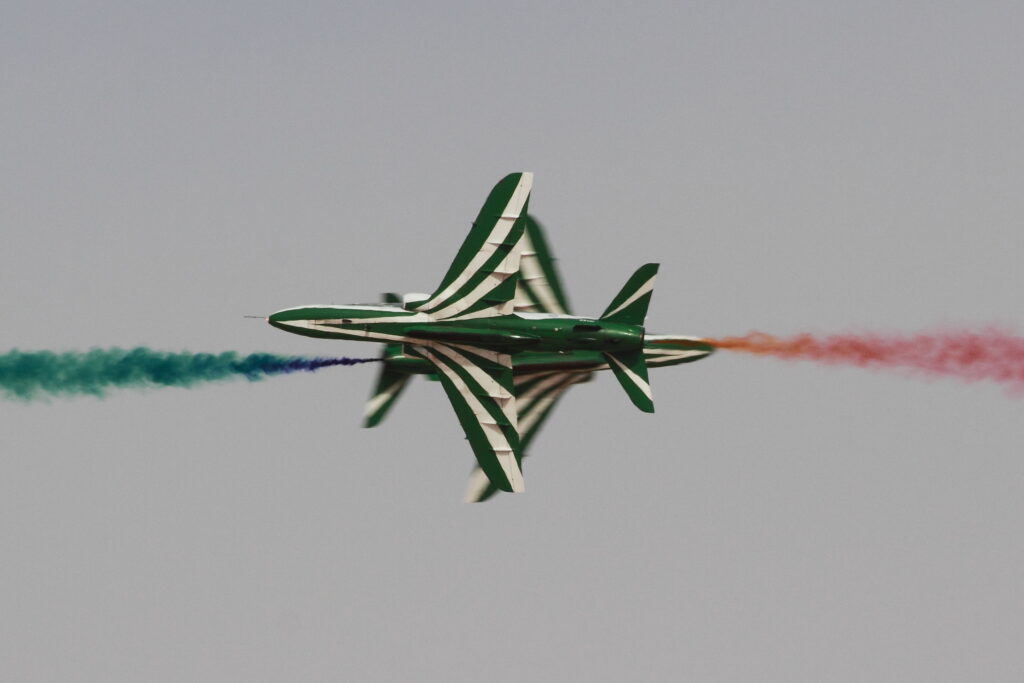
As mentioned the Saudi Hawks will convert to the new Hawk mk.165 at the end of the 2024 season, as part of the 25th anniversary of the display team. But before then, they will do their last international performances with the ‘old’ Hawk at Air Power 2024 in Zeltweg, Austria and the famous Royal International Air Tattoo at RAF Fairford, UK.
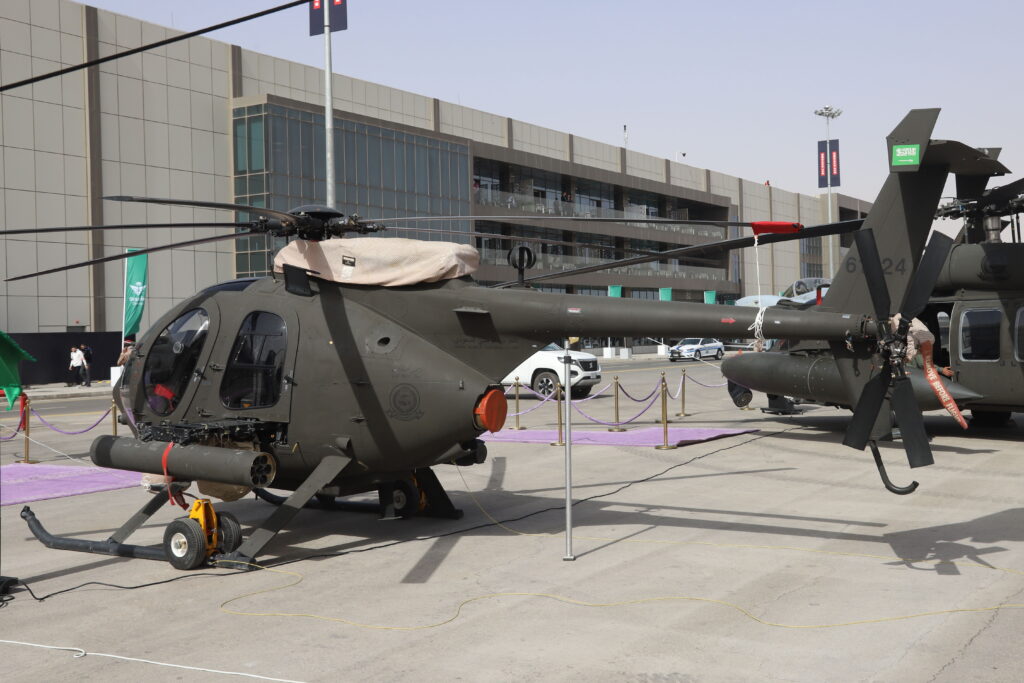
Also very rarely appearing in public are the helicopters of the Saudi Arabian National Guard (SANG). Parked in between its larger brothers AH-64E Apache Guardian and UH-60M Black Hawk, that are also operated by the SANG, this Boeing AH-6i Little Bird stole the show. With an order of 36 the SANG was the light attack helicopter’s launch customer in 2010. The ‘Little Apache’, as the helicopter is also called, can be armed with laser-guided Hellfire missiles, 70 mm guided or unguided rockets, 7.62mm Miniguns and/or GAU-19B Gatling machine guns. Just like the Apache it has a digital cockpit and under the nose is an L3 Wescam MX-15Di electro-optical/ infrared (EO/IR) turret, which can point Hellfires onto targets up to some 13 miles or 20 km away. Video can be down-linked from the MX-15 turret and the AH-6i can also receive video from other assets including UAVs, other helicopters or ground-based command stations.
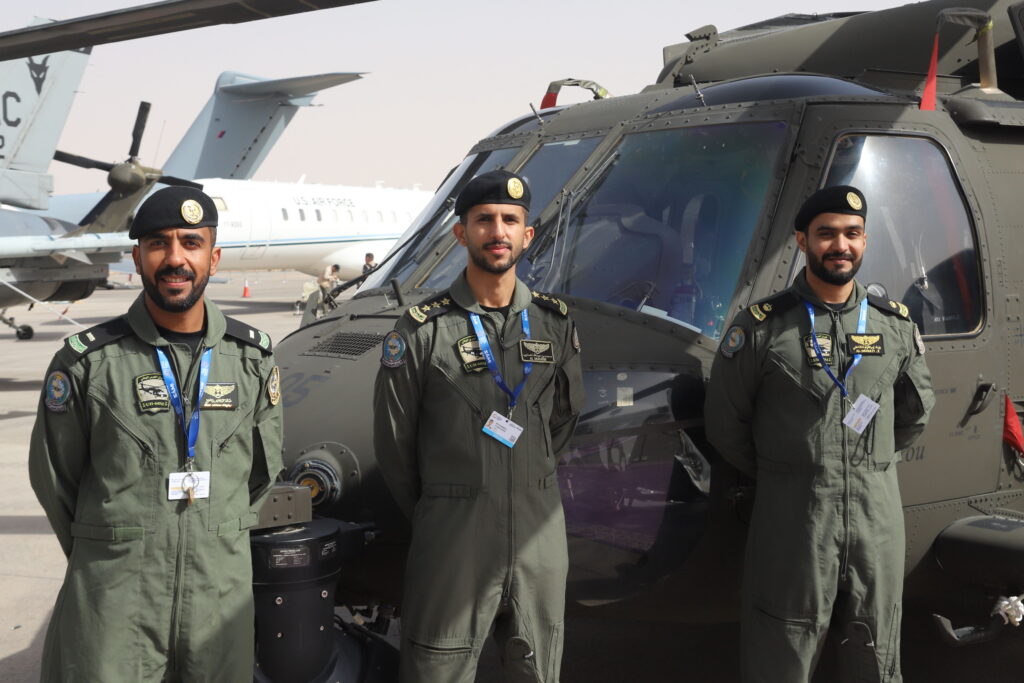
The crew posing in front of their Saudi Arabian National Guard UH-60M, the newest version of the famous Sikorsky Black Hawk. This version features a full glass cockpit and more powerful engines than its predecessors. This example and its crew are part of 1st Aviation Brigade, based at Riyadh-Khasm Alan airbase. The SANG is believed to operate 49 UH-60Ms in total, spread over four bases, although deliveries are still ongoing.
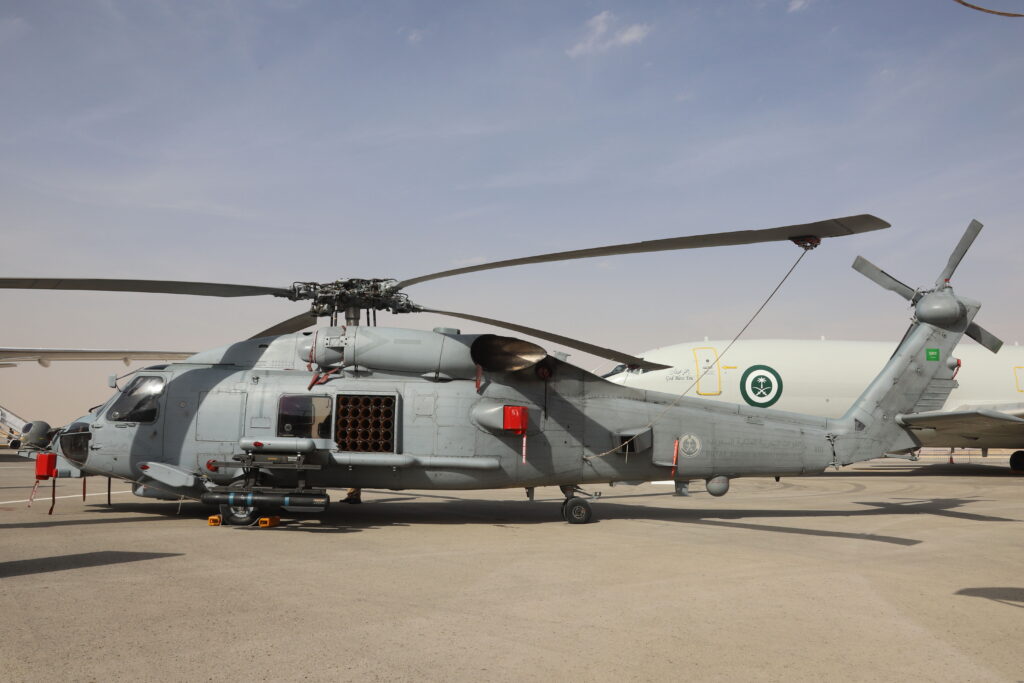
Not what you expect, in the middle of the desert: a naval forces MH-60R Sea Hawk! But that’s exactly what this is, one of 10 examples that the Royal Saudi Naval Forces acquired in 2018 and that are mainly used for anti-submarine warfare. If not deployed on one of the four multi-mission surface combatant (MMSC) ships of the Eastern Fleet, the MH-60s are based at Jubail/King Abdulaziz Naval Base. The Western Fleet is equipped with AS.332 Super Puma, AS.365 Dauphin and AS.565 Panther helicopters.
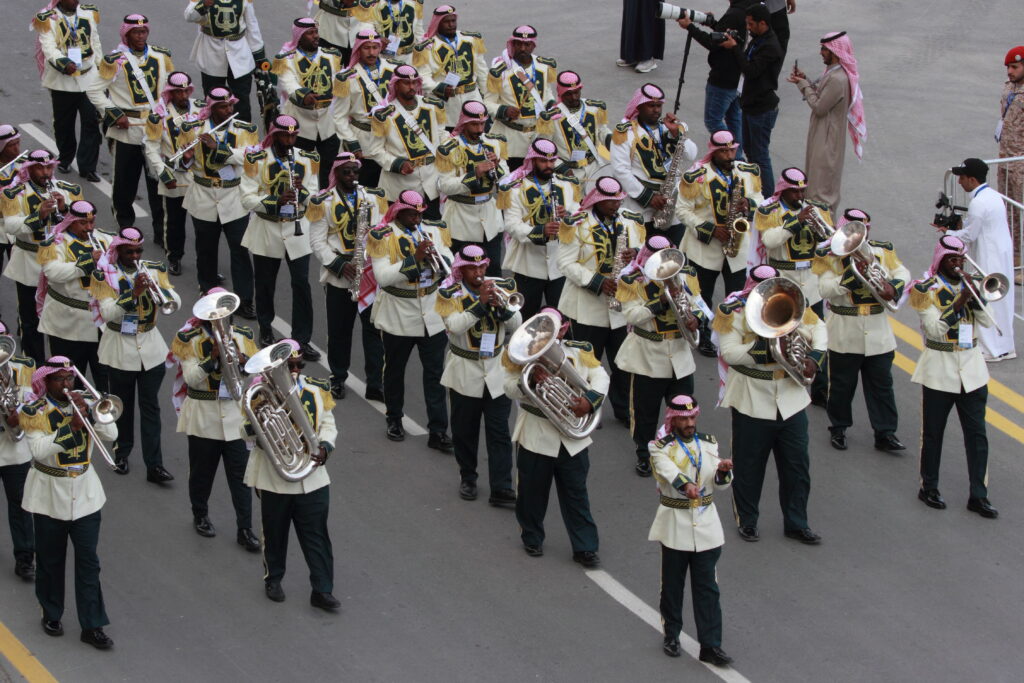
A Saudi marching band was present at the World Defense Show and performed every day, adding to the atmosphere.
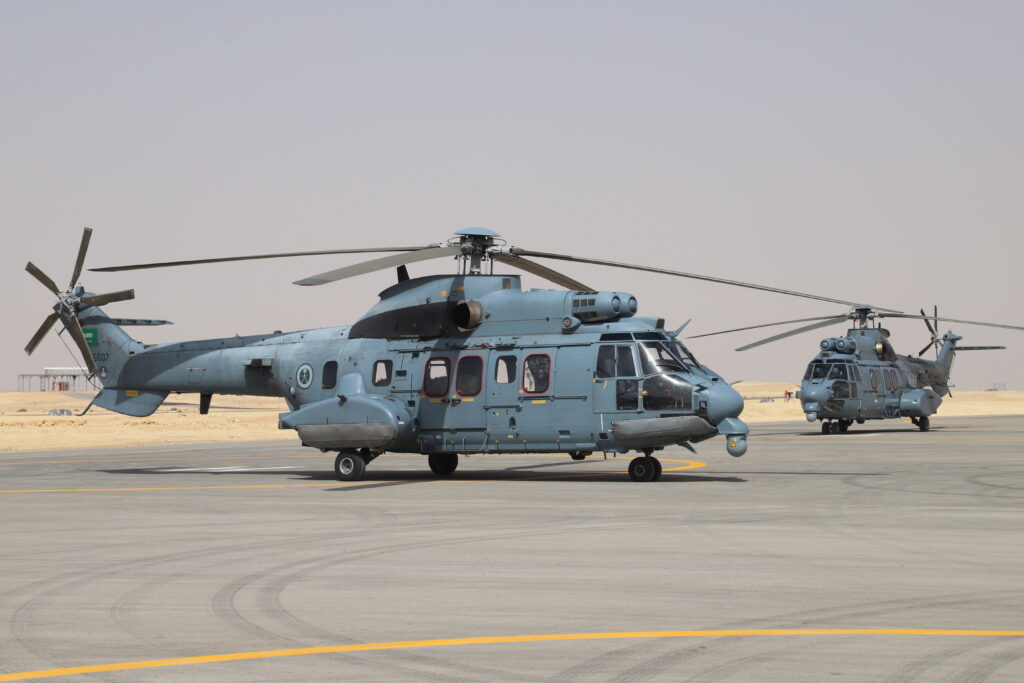
These Airbus H.215M (formerly designated as AS.532U2) Cougar helicopters of 66 squadron are used in the Combat Search and Rescue (CSAR) role. But apart from that, they can also be used for regular transport, as happened during the WDS. The one in front arrived with a V.I.P. on board, while the second one appeared to have acted as a decoy aircraft to confuse potential terrorists. A third example was part of the static display and could be admired close up. In total 7 examples have been delivered to the RSAF.
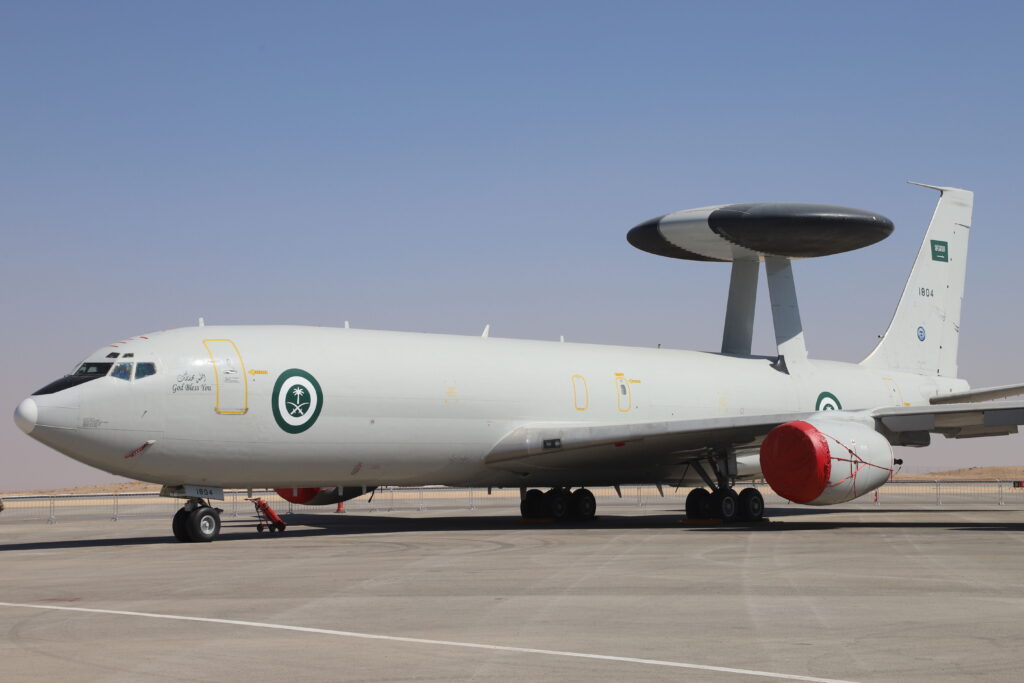
Already purchased in 1983, the RSAF has five Boeing E-3A Sentry Airborne Warning and Control System (AWACS) aircraft on strength. But although being some 40 years old, these aircraft have been upgraded multiple times and are still top of the bill. Currently running is the RSAF AWACS Modernization Program Phase 2, which should help keep the aircraft up in the air until around 2040. The upgrades are done by original manufacturer Boeing, both in Oklahoma in the United States of America and Al-Harj in Saudi Arabia, and should be finished in 2026. After the programme has finished, the fleet should be fully interoperable again with the fleet of the US Air Force. Apart from upgrading the existing fleet of E-3A, Boeing is already hoping to sell their E-7 Wedgetail aircraft to Saudi Arabia to replace the feet of aging E-3A AWACS in the future.
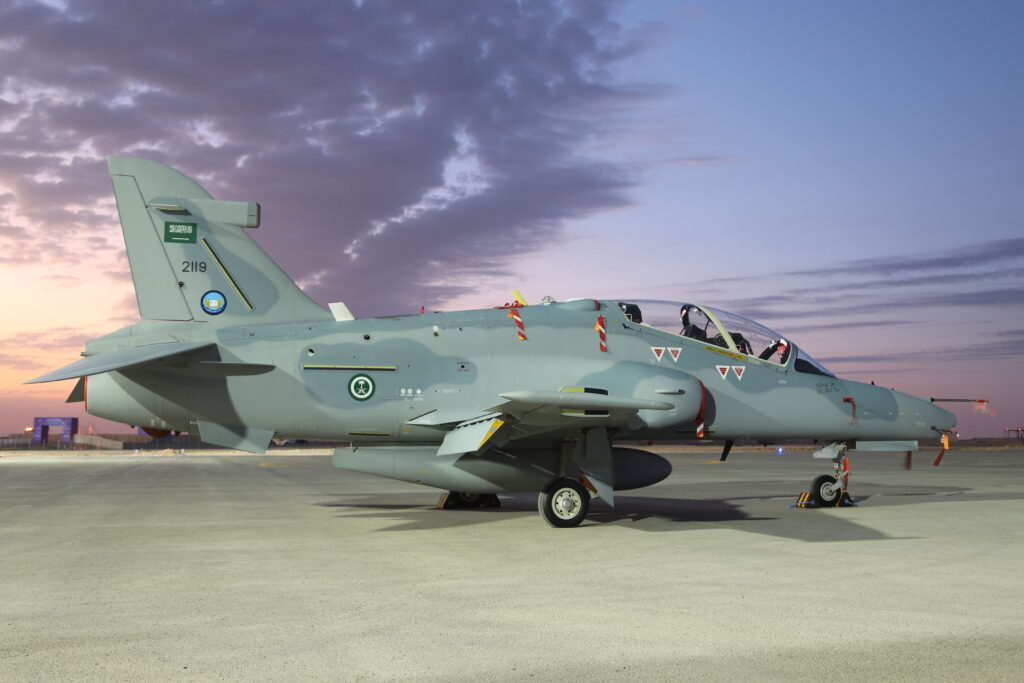
The RSAF ordered 44 British Aerospace Hawk mk.165 aircraft to replace the fleet of the older Hawk mk.65 training aircraft. The second batch of 22 of these, ordered in 2015, was to be completed in Saudi Arabia. For this the Hawk In Kingdom Final Assembly (Hawk IFKA) line was set up in Dahran, in the facility where in the past Tornado upgrades were performed. The 22 aircraft were delivered here as a kit, to be put together, test flown and painted before delivery to the RSAF. The final one of this batch was handed over to the RSAF during WDS under the watchful eyes of HRH Prince Khalid bin Salman bi Abdulaziz, the Saudi minister of defence. Although all locally assembled examples have originally been delivered to 21 and 79 squadrons, in this grey camouflage, 10 of them will be repainted and handed over to 88 squadron to be flown by the Saudi Hawks.
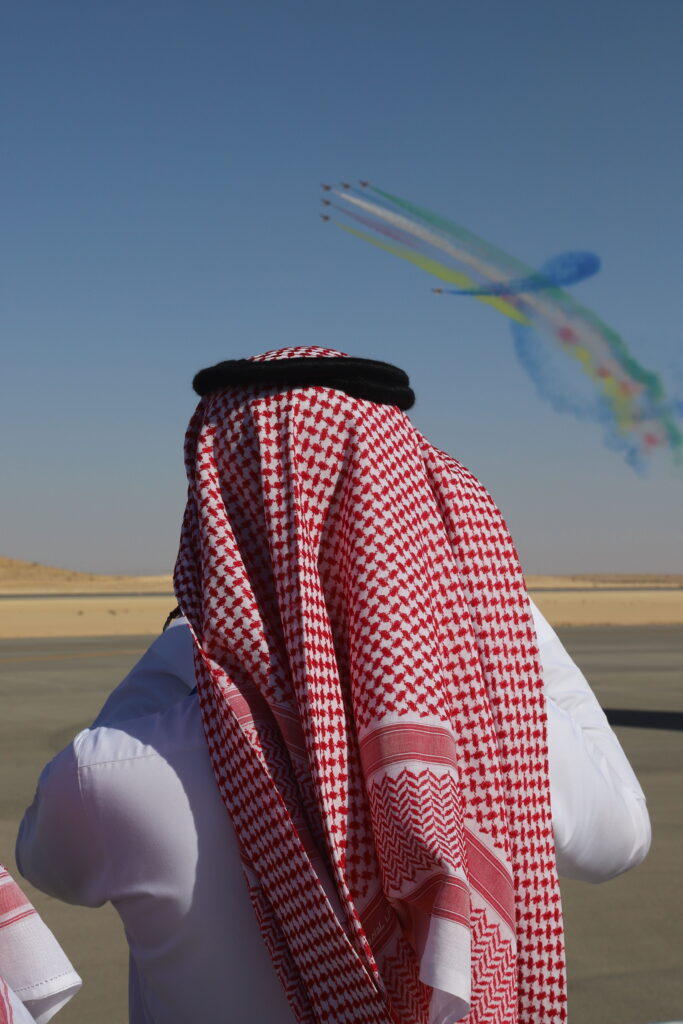
The daily aerial displays did attract a lot of attention from the crowds. In total some 106.000 visitors were counted over the five show days, and many of them brought binoculars, cell phones and cameras to the event.
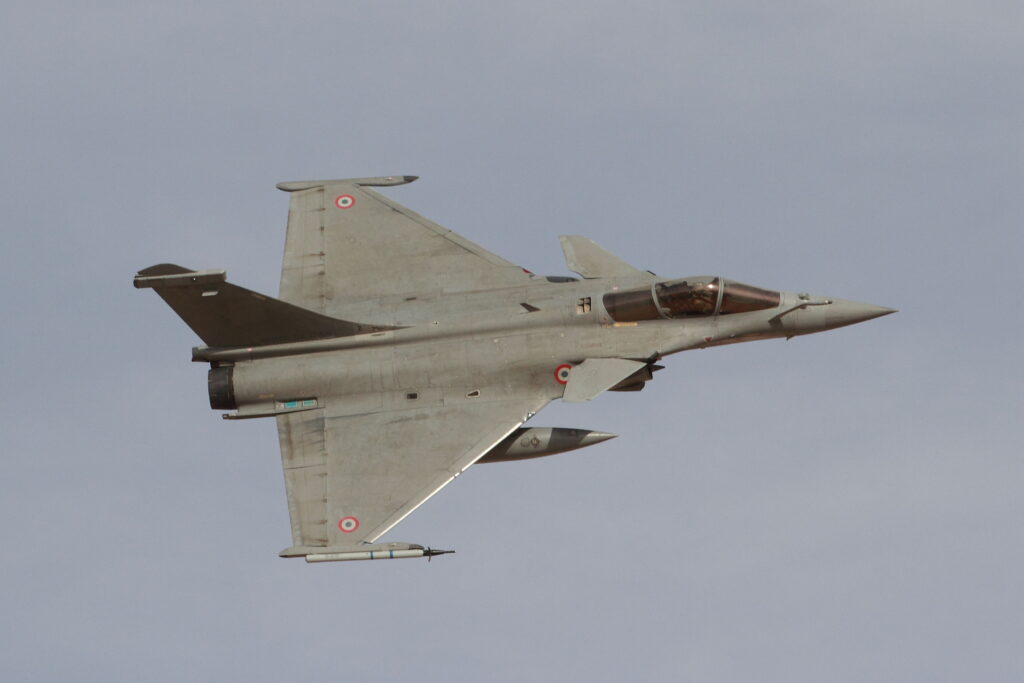
Because of the earlier mentioned embargo on the Eurofighter Typhoon, at the end of 2023 the Saudi government allegedly inquired about the Rafale with Dassault Aviation. According to the French minister of defence, Sebastien Lecornu, talks have been held about a potential sale of up to 54 Rafales. With that in mind it was no surprise the Rafale made an appearance during WDS, but strangely enough that only lasted the first day. One example was part of the static display, but already left the second day of WDS, while another one did two fly-by’s during the opening day only. Both were part of Escadre de Chasse EC01.007 ‘Provence’, currently based at Al Dhafra in Abu Dhabi, and didn’t carry any unit markings.
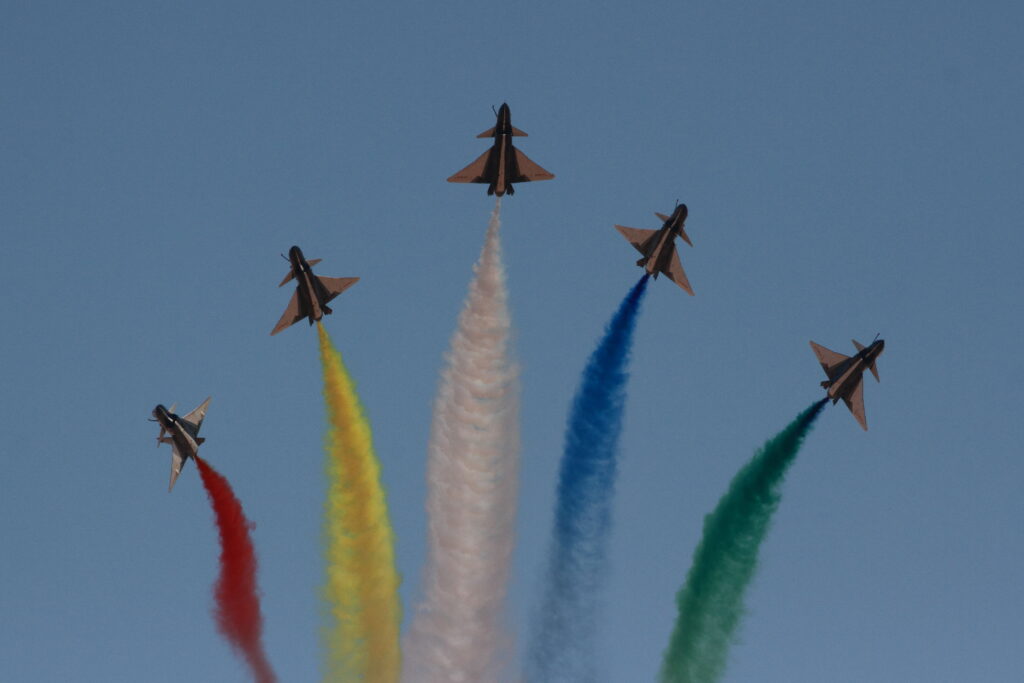
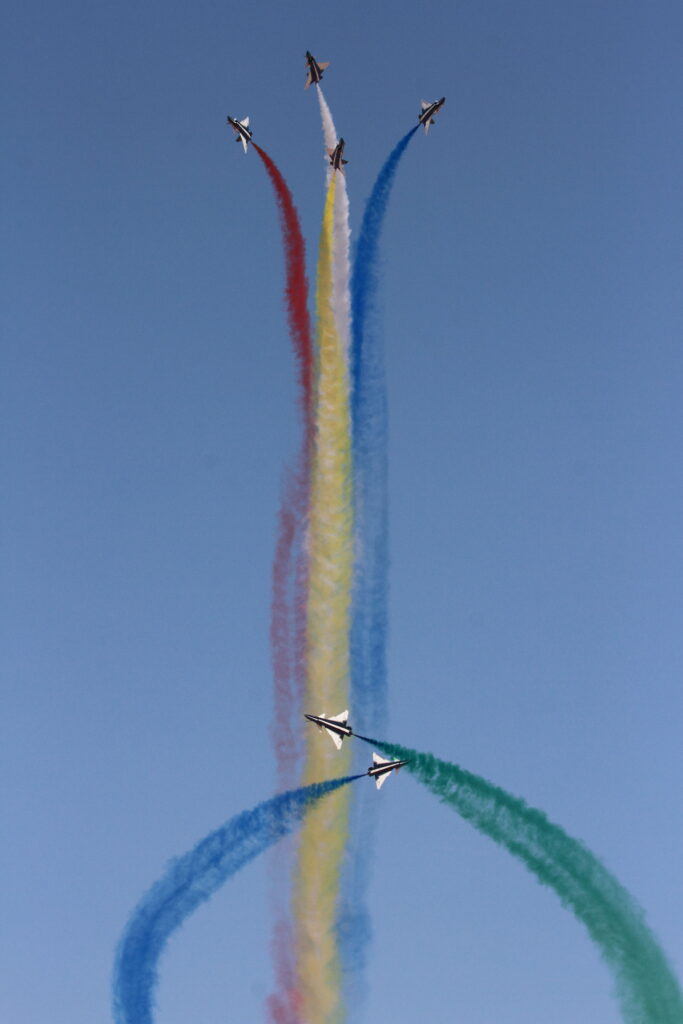
The Chinese demonstration team Ba Yi (August 1st) made their debut at the WDS. Although more than 500 displays have been flown by the team over the years, this was only their tenth performance abroad, making their rare appearance more than welcome. They were accompanied by no less than three Xiang Y-20 transport and tanker aircraft, that unfortunately didn’t stay around during the show. The team flies a spirited display and uses smoke in multiple colours, with allegedly red and yellow representing China, blue for the sky and green for peace.
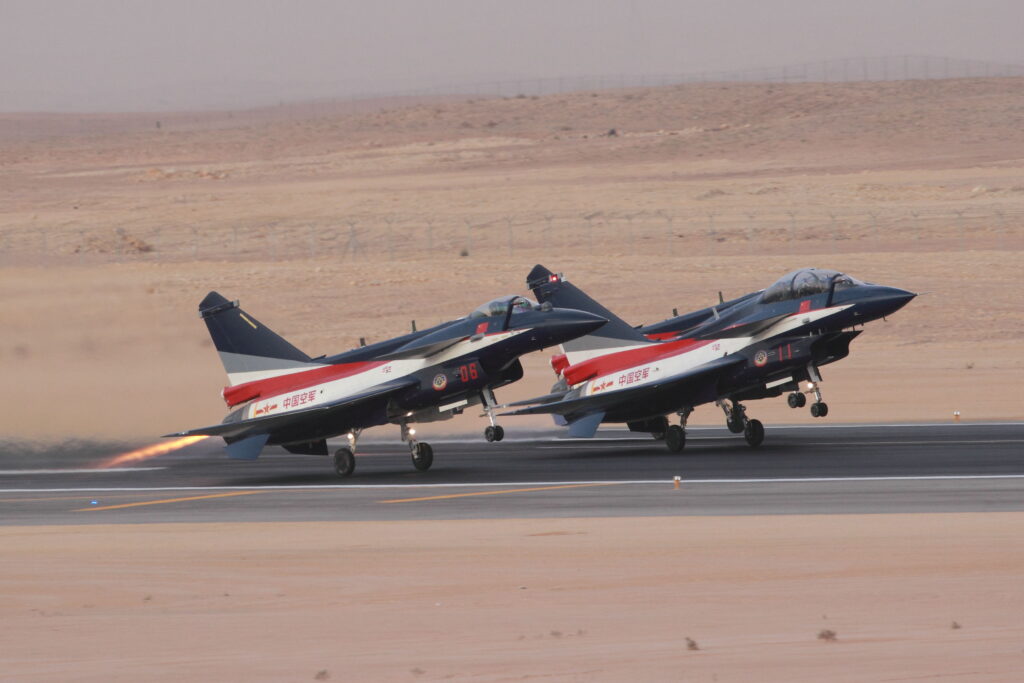
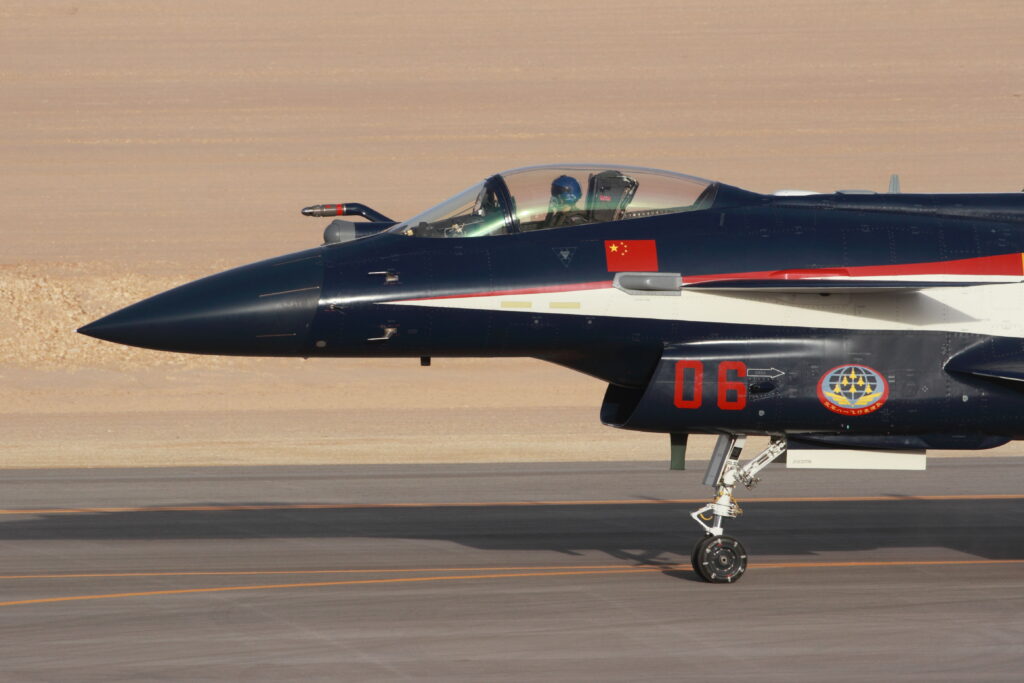
The Ba Yi team, that was already founded in 1962, is named after the date the People’s Liberation Army (PLA) was founded: August 1, 1927. The team originally flew the JJ-5, a Chinese copy of the Russian MiG-17, and later the J-7, again a copy of the Russian MiG-21. In 2009 however these were replaced by the indigenously designed J-10A which was followed up by the more modern J-10C version as recently as 2023. This multirole combat aircraft looks a lot like the Israel Aerospace Industries (IAI) Lavi, but although rumours are China and Israel worked together here, this has always been denied by both parties.
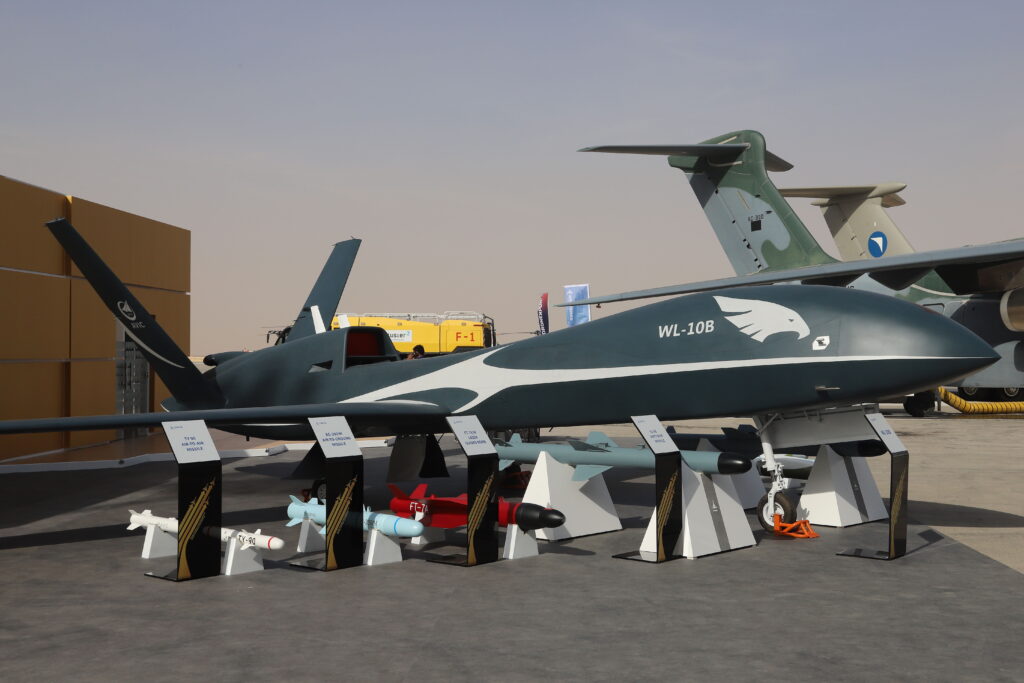
The presence of dozens of different UAVs and drones shows the changing landscape of defence. They ranged from small drones for reconnaissance to larger armed combat UAVs and even a life size one designed for transport from and to the battlefield, including the extraction of wounded personnel. One of the combat ones is this Chinese built Wing Loong WL-10B (the B denoting an export version), for which the Saudi defence forces placed an order of unknown quantity during WDS. This will become the successor of the Wing Long I and II that are already in service with the Royal Saudi Air Force since 2017. Also recently ordered by the RSAF is the Bayraktar Akinci drone, which is built by the Turkish Baykar company that thanks its claim of fame to the Bayraktar drones that are used in the war between Russia and the Ukraine. The first of these should be delivered in 2026. Comparing both UAV, the WL-10B has a higher ceiling and speed, while the Akinci is bigger and can carry a more compatible payload.
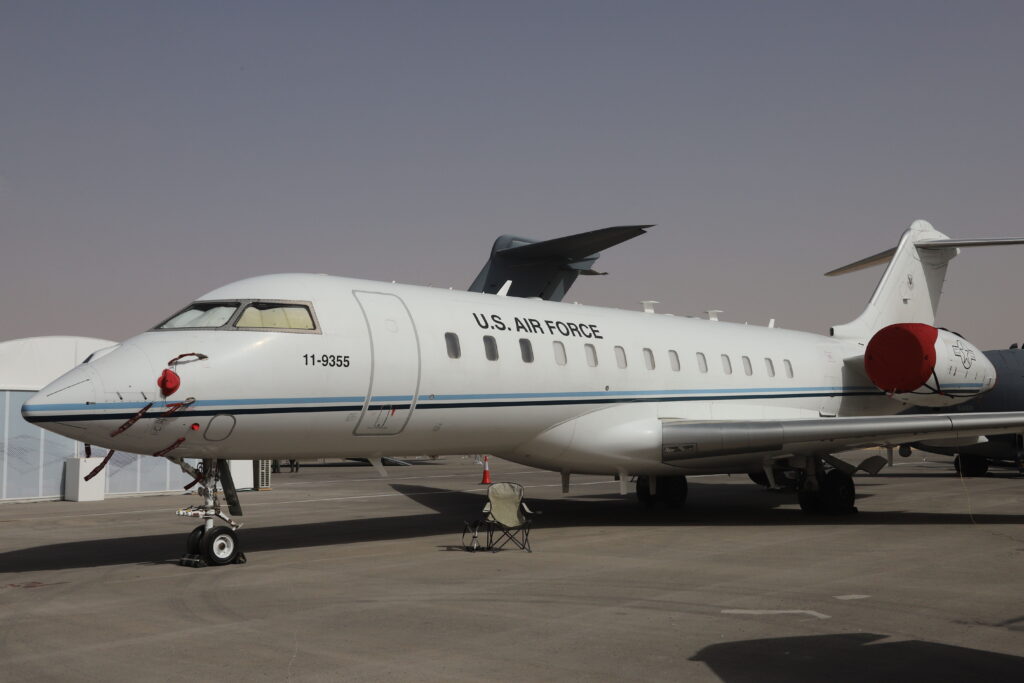
Although no 5th generation aircraft of the United States Air Force (USAF) were present “because of operational commitments”, multiple others did show, both on the ground and in the air. All are currently deployed in the area, like this Bombardier E-11A. Rarely seen on public display, this aircraft is part of the Battlefield Airborne Communications Node (BACN) together with the unmanned RQ-4 Global Hawk. Its main role is enabling real-time communication over the battlefield between all participating units on the ground and in the air.
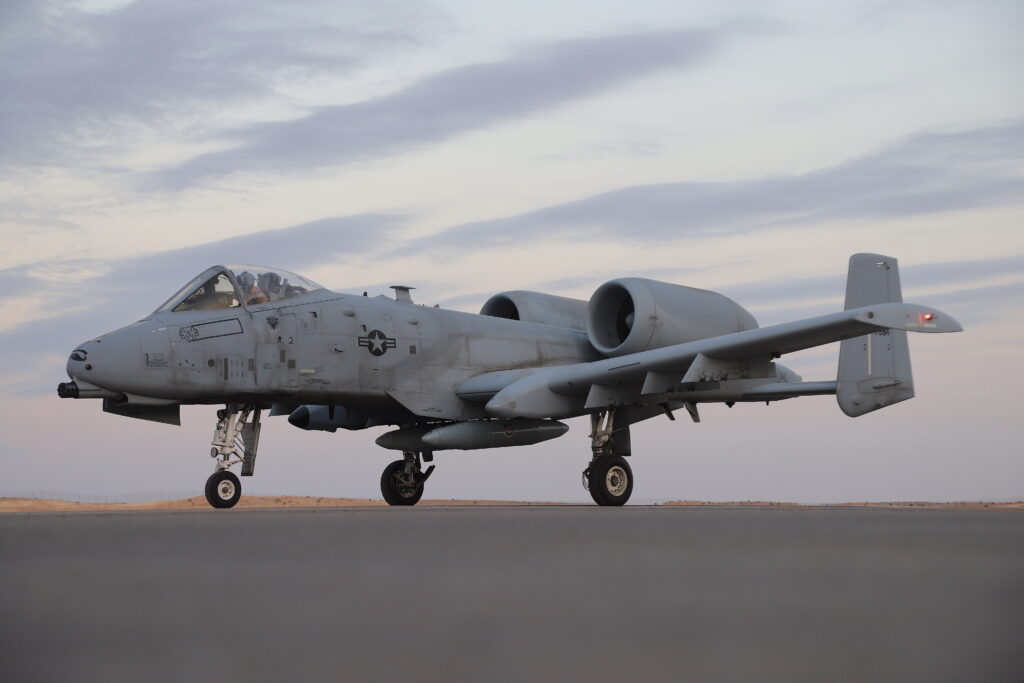
The odd one out in the American delegation was the venerable Fairchild A-10C Thunderbolt II, the tank killer that was already designed in the seventies and earmarked for retirement, but is still going strong. At WDS one was in the static display while another one was flown during the aerial display on the second day. Both belong to the 355 Wg at Davis-Monthan AFB but are currently deployed to Al Dhafra AB in the UAE as part of the 332 Air Expeditionary Wing. Major Lindsay ‘Mad’ Johnson of the A-10C Thunderbolt Demonstration Team gave a spirited display, showing all sides of the A-10C.
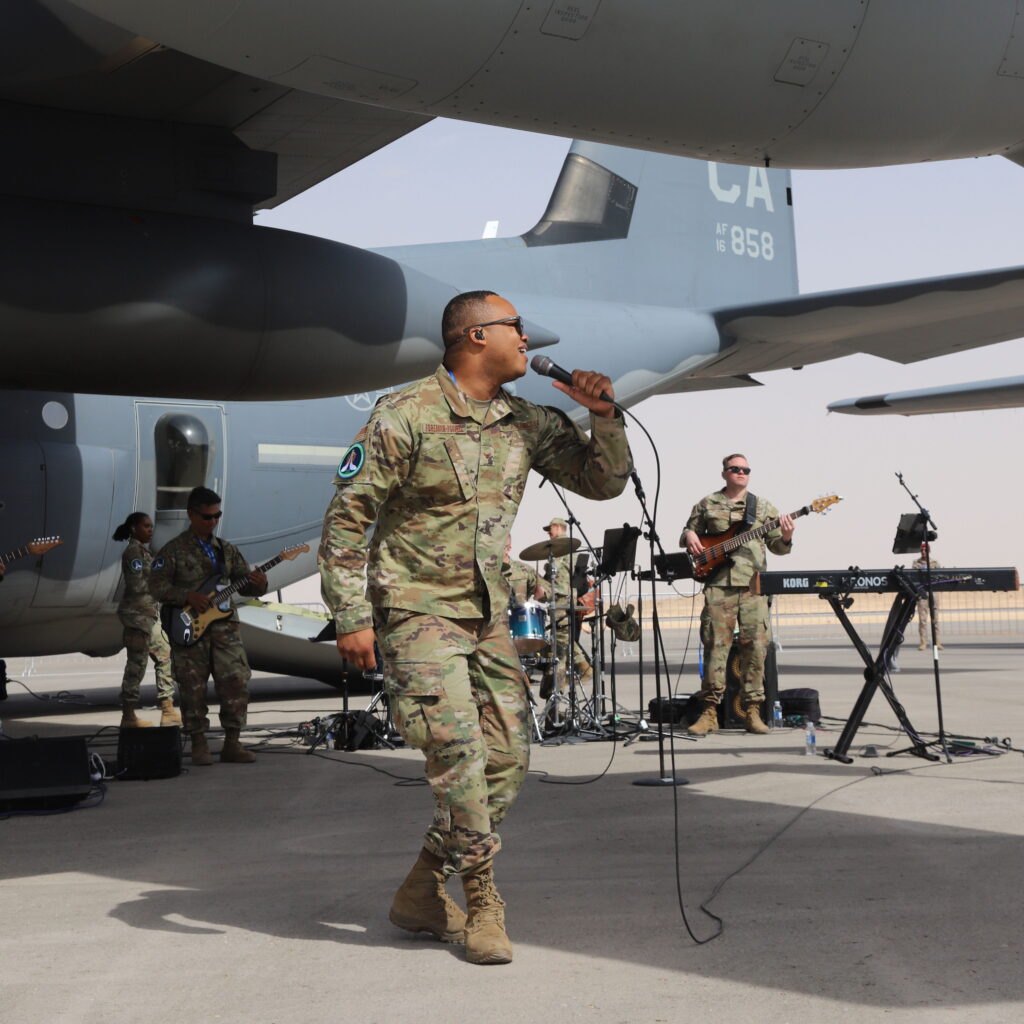
The USAF had an impressive presence at WDS 2024. According to ‘air boss’ Col. Andy Ladd of the USAF, a venue like WDS makes relationships stronger. “Building trust is the backbone of being able to work together as a coalition from multiple countries.” Definitely adding to the atmosphere, and also working on relationships, was this rock band consisting of crew members of the C-130J Super Hercules from Little Rock AFB, Arkansas that was on static display. Both enthusiastic singers managed to inspire the watching crowds, even daring spectators to play the keyboard once in a while.
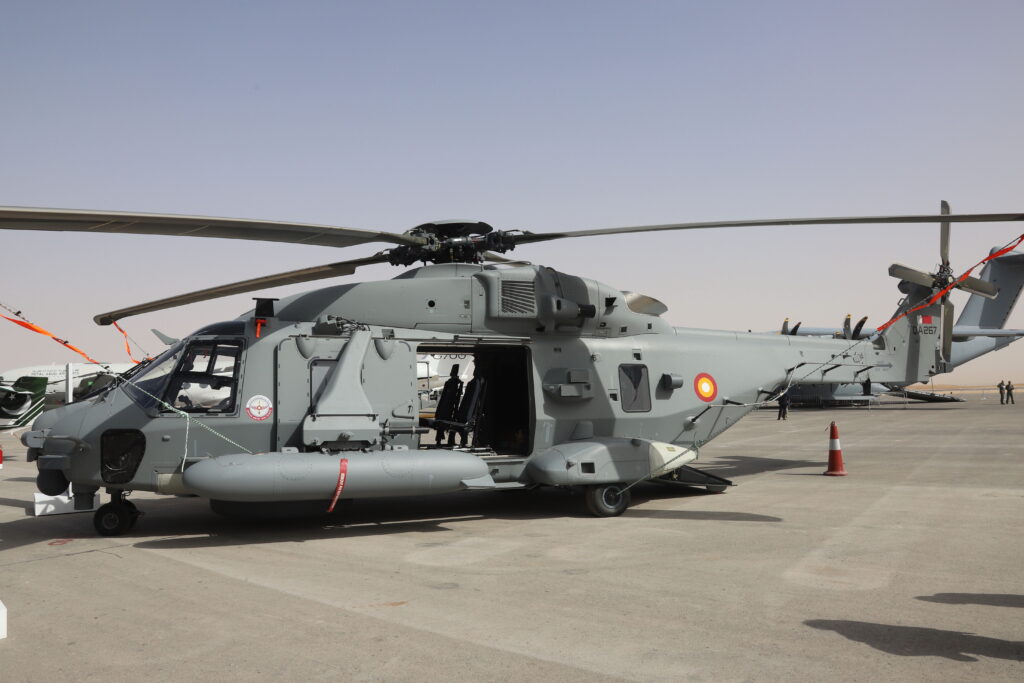
The NHIndustries NH-90 helicopter is plagued by problems in some countries, with Australia having just scrapped their whole fleet while Norway has terminated its NH-90 programme, demanding a full refund and Sweden is planning to do the same. Other operators of the NH-90 helicopter are putting their helicopters to good use though. One of those operators is the Qatar Emiri Air Force, that has both the TTH (troop transport helicopter) and the NFH (NATO frigate helicopter) on strength. One of the latter was on show at the WDS, marking the first outing abroad of the type since delivery of the first examples in 2022. The aircraft serves with 8 (anti surface vessel) squadron, based at Doha.
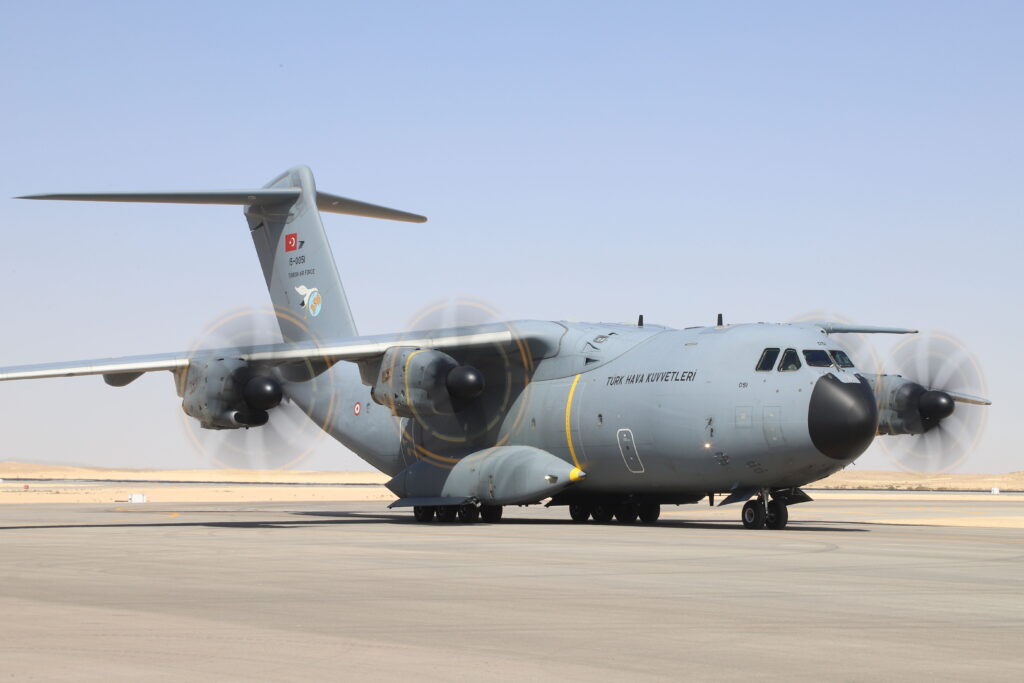
Although rumour has it Airbus is hoping to sell the A.400M Grizzly transport aircraft to the kingdom of Saudi Arabia, at WDS Airbus officials declined to discuss any ongoing negotiations. A spokesperson said: “We are in constant discussion with actual and future customers in the region and we have several campaigns in the region for the A.400M, A.330 and C-295”. Either way a Royal Air Force Atlas (as the A.400 is called in the RAF) was present as part of the static display, at the same time bringing a Agusta-Westland (Leonardo) Wildcat helicopter to the show. Furthermore a French and this Turkish example visited during the show as support aircraft for the Rafale that was mentioned before and the Turkish Stars demonstration team respectively.
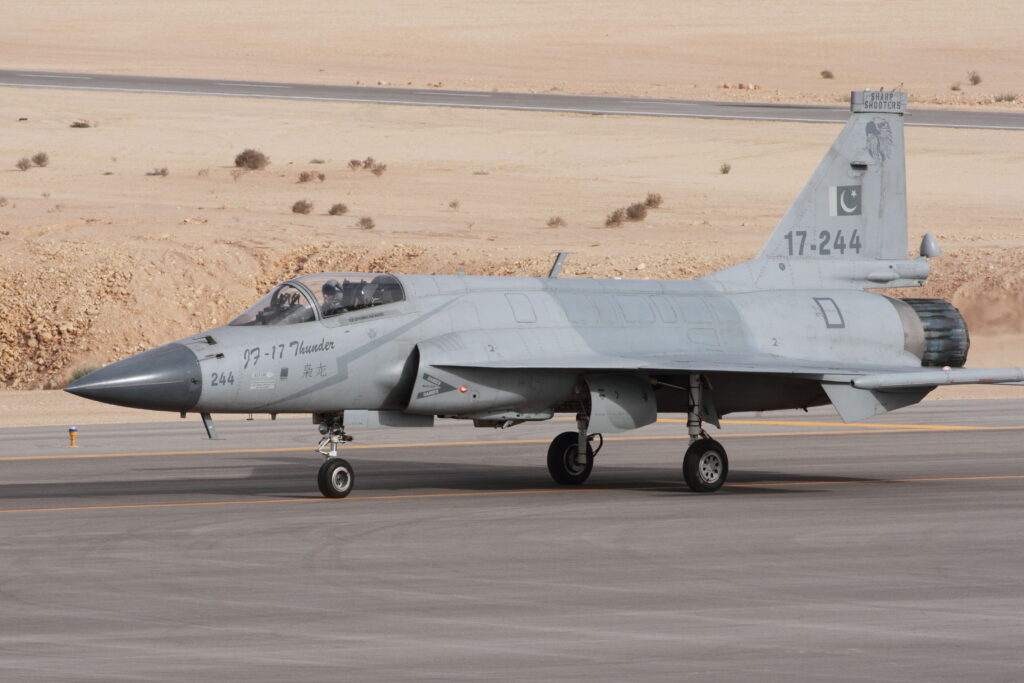
No less than three Pakistani Chengdu JF-17C ‘Thunder’ jets were present in Saudi Arabia. On static display was the brand new block III version, of which the biggest upgrade is the Nanjing KLJ-7A Active Electronically Scanned Array (AESA) radar. Two older block II aircraft alternated in the flying display. These two, one of which is portrayed here, are flown by 18 squadron ‘Sharp Shooters’, the Operational Conversion Unit based at Bholari air force base in Southern Pakistan. Fourth Pakistani aircraft present at WDS was an MFI-395 Super Mushshak in the static display, a type that is already operated by the RSAF in the elementary flying training role.
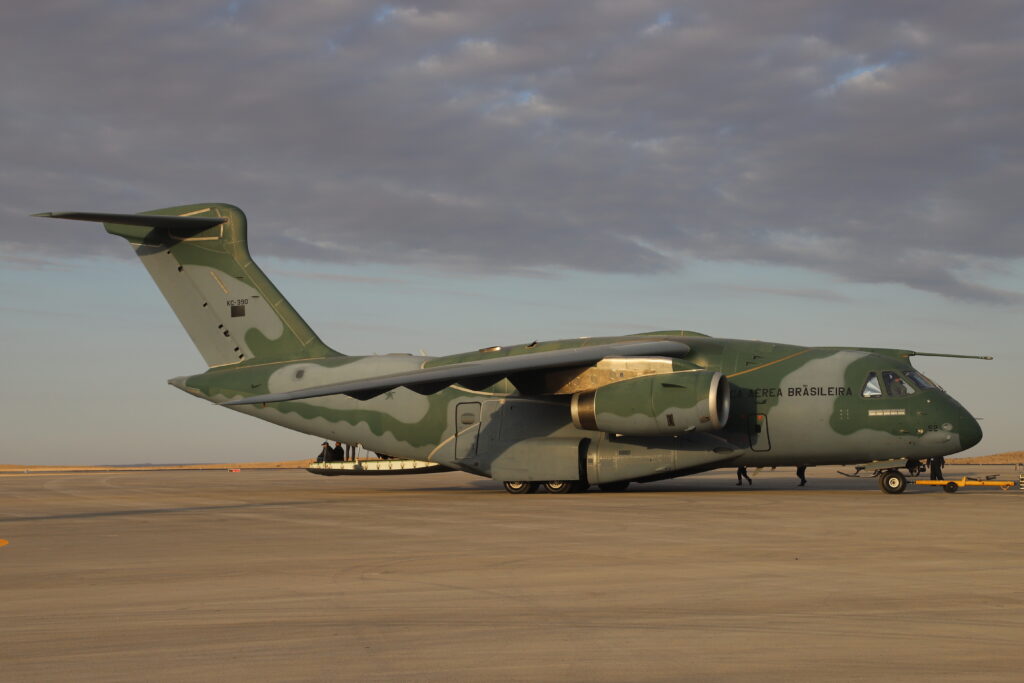
The Royal Saudi Air Force is currently the largest operator of the famous Lockheed C-130H Hercules after the USA. For the upcoming replacement however the RSAF is seriously looking at the Embraer (K)C.390 Milennium instead of the C-130J Super Hercules. Embraer is doing surprisingly well, with firm orders of Brazil, Portugal, Hungary, Czech Republic, The Netherlands and recently also South Korea. Talks are underway not only about acquisition of 33 aircraft but also about setting up a repair and overhaul centre and a final assembly line in Saudi Arabia. It was no wonder the KC-390 made a presence at WDS, while the journey from Brazil was used well by Embraer as the aircraft was also shown to Nigeria on the way.
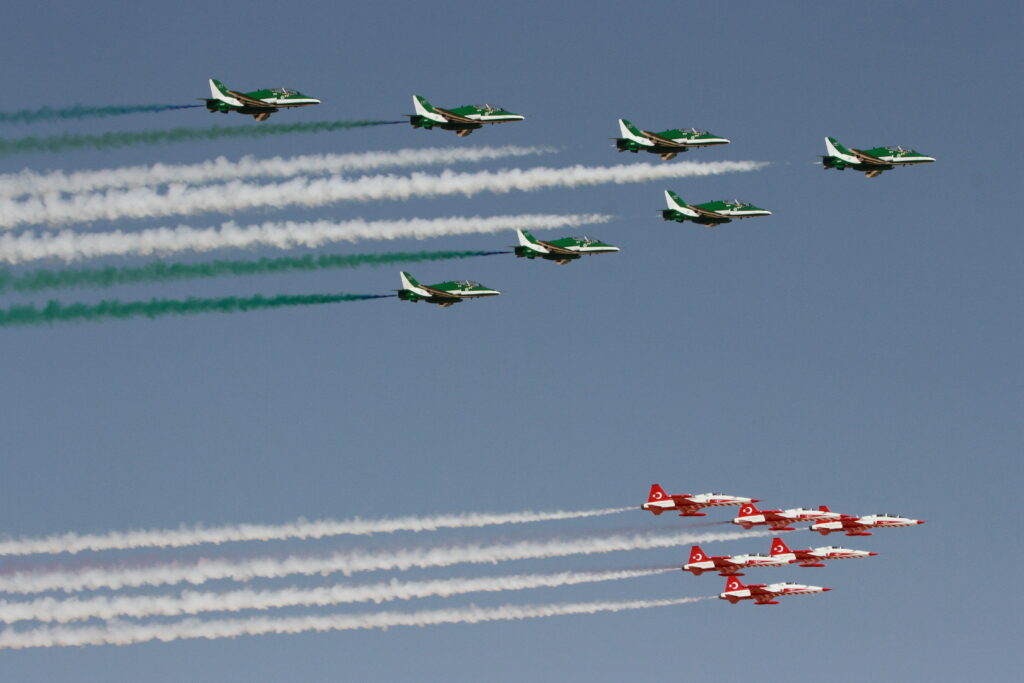
During the last show day, the Saudi Hawks and the Turkish Stars demonstration teams did a photoshoot over the desert together. When finished a few flypasts in different formations were made in front of the crowds, which gave the opportunity for this unique photograph. The Turkish Stars fly the venerable Northrop NF-5 Freedom Fighter, that started life with the Royal Netherlands Air Force but were sold to the Turkish Air Force around 1990. 30 years later they are still flying, although their end is near with only the Turkish Stars still operating them.
This article was amongst others published in Aviation News Journal and Vayu Aerospace.
